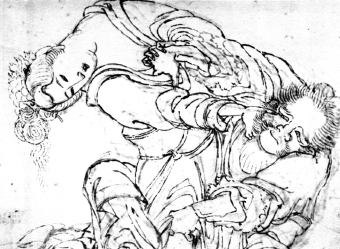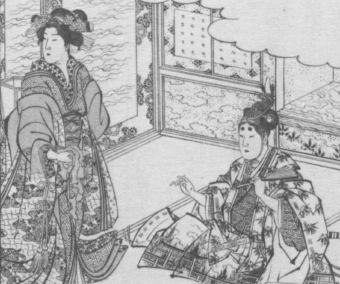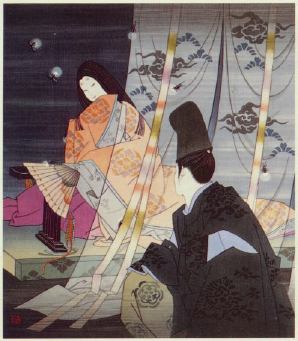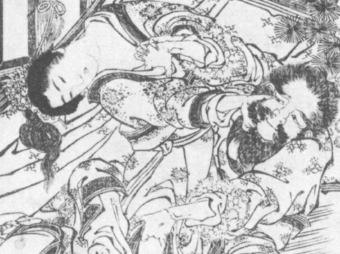Japanese Traditional Prints - Just who 'made' them anyway? ... a discussion.
Editor's note: The comments you are about to read have all been 'clipped' from a discussion on this topic that took place on the Shogun Gallery 'Chats on Japanese Prints' discussion forum in the autumn of 1998. They are reproduced here with the permission of the contributors, and of Mr. Gary Gestson of the Shogun Gallery.
The Shogun discussion board, which is highly recommended to anyone with an interest in Japanese prints, is located at:
http://www.shogungallery.com/wwwboard/wwwboard.html
Posted by DJM on October 28, 1998
Hey fellow print lovers,
I'd like to toss out a topic for debate. I have a sneaking suspicion that our art-historical approach to ukiyo-e is mistaken in concentrating too much on individual artists and less on the productive role of Edo culture itself.
1. When we truly consider the 'ukiyo-e quartet' that lies behind the production of a work, how can we continue only to assert the central importance of the designer? Isn't this merely a leftover of the 'collector mentality' (it's a Hokusai!) that has distorted our view of ukiyo-e for too long?
2. When we consider that certain signatures don't represent any artist in particular (as with Toyokuni III, who was ultimately a workshop, not a man, or the prints put out by Harunobu's students after his death with his signature etc.) how can we continue to press forward with this 'cult of the individual artist' thing?
3. Likewise, the entire deshi system of Japan stresses that a student 'copy' the style of the master until he perfects it, not that he strive off in his own direction and 'discover himself'.
4. A final piece of evidence: in certain joint works, each artist puts his 'own' style aside for the sake of continuity, producing designs so completely unlike his other that without the force of the signature, no one would recognize him. Ultimately, wasn't ukiyo-e just a question of 'giving the people what they want', as in any piece of pop culture? And wasn't it the publisher's job to put his tendrils out into the waves and feel which way the current was flowing, then direct the designer accordingly? Hokusai was the only artist capable of carving his own blocks, and when it came to color choice, the 'artist' had only a preliminary say. So I want to question all these monographs that discuss an artist's work as if his life experiences led him to it, and as if he just came up with these great ideas on his own. Isn't ukiyo-e a collective product that in the final analysis represents the people of Edo much more than any one person, the almighty creative artist?
I will step off my soapbox now.
Posted by John Fiorillo on October 29, 1998
'Individualism' in Japanese printmaking is indeed an important question and it is good to see that you have raised such a challenging topic. While the collaborative method used for producing ukiyo-e prints certainly affected the final outcome differently from other media such as ukiyo-e paintings that were usually executed solely by the artist, still I do not believe that a significant repudiation of individual artistic achievement can be supported. I would suggest the following in regard to your very interesting questions and comments:
(1) The 'ukiyo-e quartet' (artist, block carver, printer, and publisher) does not preclude the central importance of the artist, who was, after all, the designer or 'conceiver' of the composition. First, without the artist's original inspiration and its translation into at least a rough sketch (sometimes there were more finished drawings), there would be no print. Second, we must carefully evaluate what role the artist might have played in influencing the final outcome in the collaborative process - it is not true that every artist simply handed over a sketch and then had nothing else to do with the production of ukiyo-e prints (see the Hokusai 'One Hundred Poets' discussion below). Third, while what you call the 'collector mentality' does have some influence in the sphere of print valuations (particularly monetary ones), it could not be claimed that collecting egoism has been generally so dominating as to unfairly establish the centrality of the artist.
(2) I do not see why signatures would fail to represent particular artists. Whether or not an artist ran a large studio with many pupils, careful connoisseurship can often lead to distinguishing between a master's efforts and those of pupils, difficult though that might be.
(3) The deshi or apprentice system does not preclude individualism; rather, it demands working in the style of one's master(s) until that style is sufficiently mastered. Then the artist in many cases would assimilate the style and forge into new directions on his own. While it is true that certain schools seemed to produce many pupils whose works appear almost indistinguishable from one another (such as many academic Kano-school painters), the most talented of artists always seemed to find a way to produce individuated works. How else would new styles and schools of art have ever developed?
(4) 'Joint works' in ukiyo-e prints did not always require putting aside individual styles for some sort of homogeneous hybrid. The collaborative works by Kunisada and Hiroshige, for example, certainly exhibit the Kunisada's figure drawing style juxtaposed against Hiroshige's landscape style. That is, each artist provided parts of the design in his own uncompromised manner.
(5) As for 'giving people what they want,' ukiyo-e publishers certainly had their fingers on the pulse of the fashionable. Yet that does not support a claim that the artist necessarily had to alter his drawing style, chameleon-like, every time the winds of fashion shifted. For example, the always popular prints of beautiful women inspired artists in every generation to depict the beauties of their day, but I cannot see how one could claim that the style of Kiyonaga gave way to the style of Utamaro simply because the publishers would 'direct the designer.'
You are certainly correct to suggest that wider influences operated on the artist, and I agree that an artist could not produce his work in a vacuum, but surely that does not also mean that the artist would be undeserving of the primary credit for his creations. If that were so, you could argue that anyone could be an artist of repute because the influences were around all of us and so we would only have to express them. But there's the rub! A thousand people who had grown up in the same local culture could view a landscape from the same observation point and then attempt to draw that landscape, but would any of them be another Hokusai or a Hiroshige? You are, in effect, denying the creative act and the existence of genius!
Examples abound - for example, Utamaro's new feminine typology of the late 1780s and 1790s broke away from Kiyonaga's style and was the result of various factors, among them increasing interest in the depiction of realism in the arts of the period, his own fascination with individuation in female physiognomies, shifting trends in fashion, and increasing elements of Western culture as they continued to trickle in to Japan. Yet paramount above all was Utamaro's personal genius, which led him individually to develop female typologies like nothing else seen before in ukiyo-e portraiture.
I would also caution that we actually know little about the details of the printmaking process during the Edo period. Just how much involvement each artist had with printmaking is debatable and it probably varied a great deal. You seem to have concluded that the artist was some sort of preliminary artisan whose purpose was to get the collaborative process started and then move out of the way for others to create the final work. Rather, it is more likely that in general the artisans supported the artist in his attempt to realize his design in woodblock printed form. We know for certain that at least some of the time artists indicated colors on the copy sketches and sometimes made corrections to those sketches. It is also possible that artists sometimes followed the production of prints closely from start to finish, making decisions or providing guidance to the publisher as the process developed. I would therefore conclude that we are very much justified in celebrating what you call the 'almighty creative artist.'
Posted by Dave Bull on October 29, 1998
Sure, I'll bite!
My viewpoint on this is slightly different from DJM's original point, but is related nonetheless.
But I think that rather than add my 'two cents' here on this page, may I refer interested readers to a page in the [Baren] Encyclopedia of Woodblock Printmaking?
It is sometimes difficult for people living in our day, a time in which the names of many of the long-dead designers have been elevated into 'superhero' status ... Utamaro, Hokusai, Hiroshige ... to understand that these designers in many cases had very little to do with the details of the appearance of the finished prints. Quite a number of working sketches and intermediate stages have survived to our time, and these show us that the designer usually produced what we would now call a 'sketch'. The main strokes of the design were there, but all else was vague at best.
This sketch was transformed by other artists (in the publisher's workshop) into a detailed, precise, and sharply drawn 'hanshita', the sheet that would be passed to the carver to guide him in his work.
Here are some illustrations that show something of this process: - a sketch by Hokusai ...

and the corresponding portion of the resulting print.
The step that came in between these two stages - the hanshita prepared by the unnamed artist - was of course destroyed in the carving process.
Some of the old hanshita have survived though, and it by looking at these that we can get an idea of the importance of this unknown step in the production process. Here is a close-up of one such drawing - from the Museum of Fine Arts in Boston (reproduced from Jack Hillier's wonderful book 'The Art of Hokusai in Book Illustration')

Looking at this drawing, one can hardly tell the difference between it and a finished print, the resemblance is so exact. This was the man who really created our print!
But it was not only at this stage that the unknown craftsmen worked their magic. Here is another illustration - this one is a 'kyogo-zuri', a proof print taken from a freshly carved key block. Such prints were pulled when the main carving was done, and sent over to the designer to receive his recommendations on what colours were to be used in the print. Theoretically, he would carefully outline each area that was to be printed in each colour, and would provide the printer with detailed guidance on exactly what shades to use. Theoretically.
As we can see in this kyogo-zuri, Utamaro (the designer in this case) not only didn't bother outlining each area of colour, but just slapped down colour names in various places - 'blue', 'yellow', 'shiny black', etc.
When he handed this back to the publisher, that would be the end of his input in the process ... The printer would then sit with his bowls of colour, and mix magical and exquisite balances of colour from those few simple words of instruction. This was the man who really created our print!
But who do we remember now - that man who carefully drew every line in the print? The carver who brought those lines to life? The printer? No, the only name we remember is that of the man who brushed that original sketch ...
Is my bias on behalf of the craftsmen showing perhaps a bit too strongly? Perhaps it is - but there have been many millions of words written about Utamaro. It won't hurt to have these other men gain just a little bit of recognition ...
In answer to DJM's question: 'how can we continue only to assert the central importance of the designer?' ... I believe that we are long long overdue for a re-assessment, and a recognition of the part played by the other men involved in print production.
Continuation of John Fiorillo's posting of October 29, 1998
I was pleased to see David Bull's suggestion that we might read his page on Woodblock Printmaking, a very informative website! Still, I would respectfully take issue with David's claim that the professional copyists (called hikko who traced the hanshita-e (block sketches) were the men who really created the prints!!! I suppose if what David means by 'prints' is the actual printed paper bearing the design of lines and color, well, then, one could say that only those artisans who physically touched the blocks, the paper, and the pigments would deserve credit for creating it. But this is semantics! A 'print' as we understand it most certainly means more than that - it is the composition or the artist's unique vision translated into the physical medium of paper and pigments. Seen this way, the primary constituent of a 'print' is the design created by the artist (who deserves primary credit). The fact that the design is then translated by copyists, engravers, and printers is important, but it cannot deny the artist the credit for his inspired contribution. A Hokusai print is elementally a Hokusai, NOT a Hokusai cum artisans, though the latter certainly influenced the final translation into prints.
Some other thoughts occur to me. First, whether artists themselves created the hanshita-e is still being debated, but there is evidence that some artists might have indeed made hanshita-e. Copy drawings for Hokusai's series 'One Hundred Poets' series, for example, might very well have been drawn by the artist, and in some cases he made crucial changes in the copy drawing designs. Second, even if very few artists made hanshita-e, we would be denying the plausible conjecture that when artists created preliminary sketches (called shita-e), they were carefully considering the ultimate goal, which was to create a block print.
In other words, I would argue that many artists drew their preliminary designs in ways conducive to final block printing that would be different from drawing preliminary designs for paintings. Artists knew very well what could be achieved in blockprinting. They needn't draw in every line, every detail, because they as well as the copyists, carvers, and printers knew what could be done once the main composition was created. Sometimes the details had a significant effect on the designs, at other times not so much.
The same issue holds true for colors as well. It would also be questionable to say that an artist merely indicated colors while the printers mixed them, thus suggesting that the printers deserved the credit for the palette and were more the creators of the print than the artist. First, how do we know that when the artist indicated 'blue' on the trial proof that both he and the publisher (or the printer) did not already know what basic shade the artist meant (what David nicely calls 'magical and exquisite balances of color')? Could it not have been worked out beforehand or at least generally understood based on experience or current practice? Second, how do we explain that so often there was a consistent palette for one artist over long periods of time, even when the prints were issued by many different publishers (who typically employed their own staffs of carvers and printers, though this gets complicated because apparently some engravers and printers were partly independent and worked for various publishers)? Surely such consistency despite changes in the publishers and artisans would suggest there was at least some involvement by the artist beyond simply supplying sketches.
I do not mean to diminish the significant contributions of carvers and printers, I only mean to defend the artist as the primary creative force in composing the design, the most essential element in the printmaking process.
David also asks on his website whether his 'bias on behalf of the craftsmen show[s] perhaps a bit too strongly?' Well, I think it does, but I really do sympathize, and it is truly a shame that these marvelously gifted craftsmen are hardly known to us today. One of my favorite artists, the Osaka master Hokuei Shunbaisai (active c. 1827-1837), collaborated with two enormously talented engravers, Kasuke and Kumazo It is likely that Kasuke was influential in moving Hokuei toward a more expressive and more experimental method of print design because he offered Hokuei his wondrous skills in translating design and emotion into woodblock carving. As a result we have some Osaka masterpieces not only because Hokuei was an inspired and highly skilled artist, but also because Kasuke could translate Hokuei's vision into carving the block. Yet all we have now is a carver's name. Kasuke deserved more!
Posted by DJM on October 29, 1998
John, you are certainly right that I overstated my case. I don't mean to deny the artist a place, and perhaps even the central place, but rather to suggest that it's time we looked beyond the artist (and certainly to the facts of his biography for an explanation of his work)and saw the other factors influencing him. It does seem that the essential tension in the development of ukiyo-e is between 'giving the people what they want' and 'telling the people what they (really) want.' There's tons of derivative work in any form of pop culture, but you're right, someone somewhere along the line has to spring into creative individuality to spur things along in another direction.
Here's my objection to your putting all the responsibility for this with the artist though: it was ultimately the public that decided if an innovation would be successful (and hence a new form for derivative work) or not. We all know Michener's famous example of Kuniyoshi's abstract Fuji that failed to catch on--and I'm sure we can come up with dozens of other cul-de-sacs in ukiyo-e history (it might make an interesting book).
So, to sum things up, I'm not trying to completely deny the creativity of the artist, just trying to suggest that there's more than that to the historical development of ukiyo-e. Again, I think we have to give attention to the directing role of the audience of ukiyo-e as well as to the performance of the designers.
As for any given print, as David's website proves remarkably, it's ludicrous to say 'it's a Hiroshige' as if that explained everything. A given print is a combination of so many forces, both material and abstract--and that to me is part of its beauty. It's truly a cultural artifact, not the remains of any given individual, and all the more powerful for that.
Thanks to John and David for biting!
Posted by Dave Bull on October 30, 1998
I hope that my comments in 'support' of the carvers and printers won't be taken as a 'repudiation of individual achievement' for the artists. I am very much aware that I am at least as biased on the side of the craftsmen (whom I feel have been very unjustly ignored), as are the 'famous' writers who write about the 'famous' artists.
Of course without the designer, all would be nothing. But think of just what it is in a woodblock print that we love - yes an interesting design. But we also love the clarity and definition of the incised lines, and the beauty of the fluid 'brush' strokes. We love the indescribable delicacy of the colours, and the way that two colours side by side have been chosen to 'blend' with each other perfectly. And these things that we love come to us directly from the hands of the craftsmen. I know this - from nearly twenty years of sitting at my carving and printing benches working on reproductions of Japanese prints!
It is certainly possible that in some cases the 'Utamaro' (or whoever ...) sat down with the printer and guided him in the blending of the colours. I have no crystal ball to look back into the past to confirm or deny this. But I am as certain as I can be, that any such instances would have been only in the case of very special publications. For 99% of normally published prints, it is my opinion that none of the people involved would have thought that such close guidance was necessary. The printers were completely capable of doing an 'Utamaro' palette.
To grab at a rather weak analogy, how about the way that books are made? Very few authors have any say (or interest?) in the way that their book is physically produced - what typefaces are used, what the pH of the paper is, whether or not the page numbers are in italic type or not, etc. etc. But all these things (and a million other details of construction) play a great part in how 'beautiful' the finished book is. It's simply that there is a clearly defined division of labour, with each person contributing in his/her own sphere or specialty.
And (to get back to printmaking) I have personal knowledge of an instance here in Tokyo a few years ago where a set of prints was made from designs supplied by a very famous designer. The publisher took the originals (in watercolour line and wash), had them drawn into hanshita form, carved and then printed. When the proofs were sent to the artist, he suggested a few alterations, and then signed off on the resulting proofs. He knew at the beginning that the carver and printer had the experience and deep knowledge necessary to turn a design into a print. He accepted that his own part was to supply the 'design', vague as it might be.

This is turning out to be a great discussion on a very interesting and complex topic!
'Wrap-up' by John Fiorillo on October 31, 1998
Hello David, I basically agree with what you have just written in your follow-up. There seems no doubt that the brilliant skills of the finest Edo period carvers and printers were essential in raising the art of the Japanese print to a level unmatched in block printing anywhere else in the world.
What I was concerned about in my earlier comments was erring too much in either direction, that is, assigning too much credit to either the artist or the artisans when we all should recognize the collaborative nature of woodblock printing. I was also concerned that while admiring the skills of the artisans one should not declare that they 'created' the compositions we see on the printed sheets - what they did was 'execute' or 'translate' the images, surely a creative act in itself but not equivalent to creating the composition, which is the most elemental aspect in Japanese printmaking because all else derives from the artist's vision and his laying out of that vision onto a sheet of sketching paper.
That is why I can view a Japanese print signed by Utamaro and feel totally convinced that it is indeed an 'Utamaro,' even though I recognize that craftsmen made the wonderful, long-fibered paper, carved the blocks, selected the colors, mixed the pigments, and rubbed those pigments onto the paper.
The discussion did not end at this point ... but the topic 'morphed' into something else - an investigation of how carved lines differed from the lines originally produced by the designer. If you are interested, that continuation can be found here.
